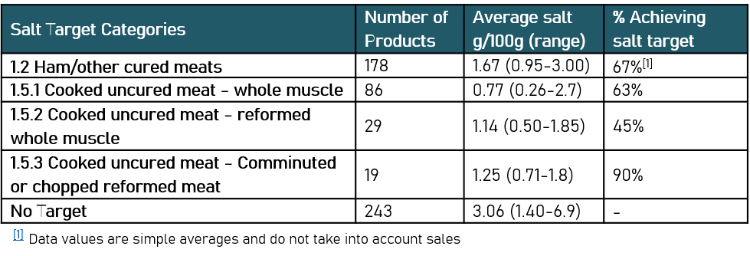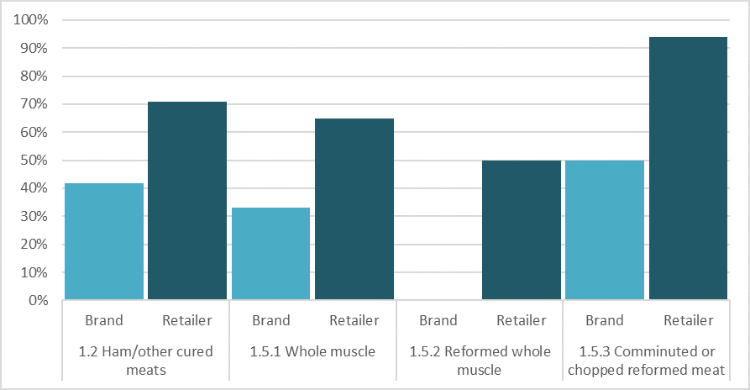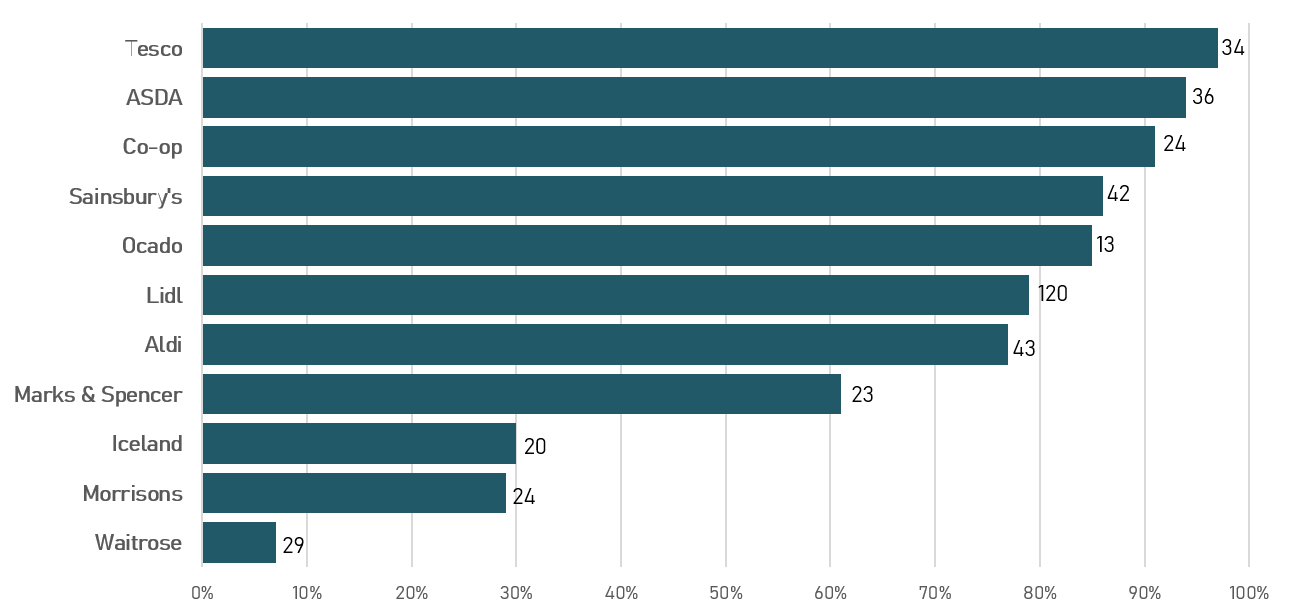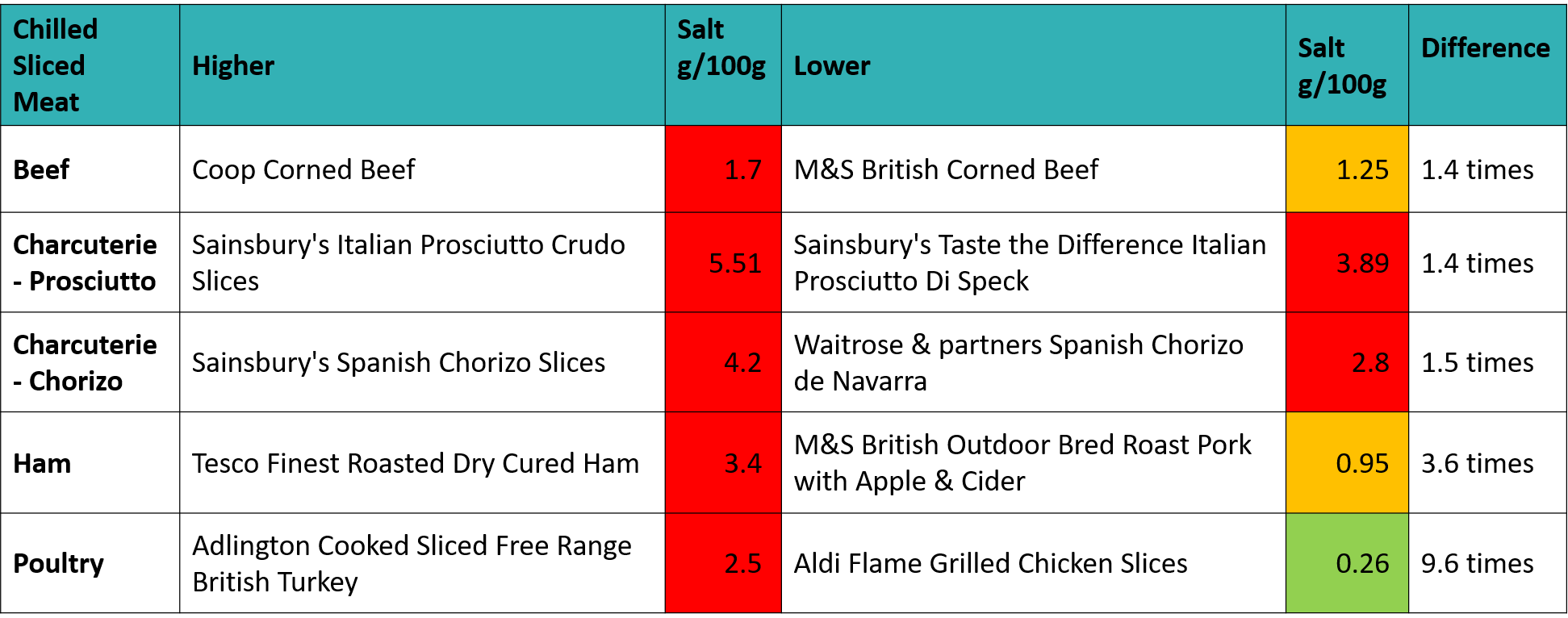Chilled Sliced Meats
1 in 4 Chilled Sliced Meats Sold in the UK are Saltier than Atlantic Seawater, according to NEW Data
- Two thirds (65%) of all chilled sliced meat (ham, chicken, salami etc) sold by major grocery retailers are high in salt with 1 in 4 (25%) products saltier than Atlantic seawater[i]
- New data shows a staggering 23-fold difference in salt content across all products
- One third (35%) of chilled sliced meats fail to meet the salt targets[ii]
- Action on Salt is calling for mandatory, comprehensive salt reduction targets to be enforced with penalties for those food manufacturers who fail to comply
View The Salt Content of Chilld Sliced Meat Report [PDF 4,362KB]
View the Media Coverage here
NEW research[iii] by Action on Salt (based at Queen Mary University of London) has revealed that two thirds of all chilled sliced meats including sliced ham, chicken, corned beef and salami sold by leading grocery retailers are dangerously high in salt (i.e. >1.5g/100g) – with one in three (35%) failing to meet the national salt reduction targets.iii
Action on Salt is now calling for mandated salt reduction targets for all products containing added salt to be enforced (and reviewed regularly) by the Government. This will ensure that ALL manufacturers and retailers meet both the current and future targets, creating a much-needed level playing field. Failure to comply should be penalised, say the experts.
Food companies have made appalling progress in this category of food considering the salt targets set in 2006 have not been amended (unlike other food categories) due to lack of progress.
Food manufacturers in particular are lagging behind, with only one in three (37%) of their chilled sliced meat products achieving their respective salt targets, compared to two in three (69%) of retailer’s own labelproducts. Tesco is leading the retailers in compliance with the targets compared to Waitrose which is falling far behind (97% vs 7% respectively).
Of all products surveyed, the average salt content is 2.1g/100g, meaning nearly two thirds (65%) are considered high in salt and a disappointing four products considered low[iv]. The salt content varies from 0.26 – 6.0g/100g across all surveyed products – which is a whopping 23-fold difference! But there is also a clear and wide variation across each of the different types of chilled sliced meat[v]. For example, within poultry products there is a difference of 2.24g salt between the least salty (Aldi’s Flame Grilled Chicken Slices at 0.26g/100g) and the saltiest product (Adlington Cooked Sliced Free Range British Turkey at 2.5g/100g) – which is as salty as seawater[vi]!
Whilst salt per suggested portion size (as stated on pack) averages 0.6g, due to inconsistent portion sizes (which range from 1x slice to half a packet across food companies), certain manufacturers are offering up as much as 1.73g salt per portion for ham, and 2.3g per portion for charcuterie meats. For example: M&S British Wiltshire Roast Ham contains 1.73g of salt per portion (3 slices) – that’s nearly one third (29%) of an adult’s and more than half (58%) of a child’s (4-6 years old) maximum recommended daily salt limit[vii]. If consumed as part of a single sandwich, then this would contribute almost half (45%) of an adult’s daily salt limit[viii].
Surprisingly, many chilled sliced meat products with the highest overall salt content are exempt from the UK’s voluntary salt targets[ix]. These were predominantly charcuterie meats (e.g. prosciutto, chorizo etc) and traditionally cured hams (e.g. Wiltshire cured ham) – all of which still vary in salt content. For example, Sainsbury's Italian Prosciutto Crudo has 5.51g of salt per 100g (more than twice the concentration of seawater), compared to Sainsbury's Taste the Difference Italian Prosciutto Di Speck, which contains 30% less salt at 3.89g/100g. This demonstrates that vastly reduced levels of salt are achievable, even in the most challenging of products.
Sonia Pombo, Campaign Manager for Action on Salt, said:
“Why are these everyday sliced meats, which are frequently consumed by children, so high in salt when it is clearly not required for taste or food safety? Whilst some salt may be needed in processed meat, there is scope for extensive reductions, as demonstrated by some of the more responsible companies. There’s no excuse. Other manufacturers must now follow their lead and put their customer’s health first.”
Mhairi Brown, Policy & Public Affairs Manager for Action on Salt, added:
“Voluntary salt reduction targets have been a key feature of public health policy in the UK for many years. After initial success, which inspired more than 50 countries to follow suit, progress has stagnated in the UK, whereas many other countries have gone further and introduced mandated targets. If the UK industry can no longer comply with voluntary measures, then now is the time for mandatory, comprehensive salt reduction targets to ensure success and create a level playing field.”
Graham MacGregor, Professor of Cardiovascular Medicine at Queen Mary University of London, and Chairman of Action on Salt, said:
“Reducing salt is the most cost-effective measure to lower blood pressure and reduce the number of people suffering from strokes and heart disease and life changing disabilities associated with this – all of which is completely avoidable. It’s a disgrace that food companies continue to fill our food with so much salt when there is the option to reformulate, which our research shows can easily be done. The Government needs to force the industry to comply, to ensure that many thousands of people don’t die unnecessarily."
Data Summary
Table 1. Average salt content per 100g and percentage of chilled sliced meat products achieving their respective salt targets. NB These salt targets include other food categories which have not been included in this survey e.g. canned and frozen meat

Figure 1. Proportion (%) of products complying with the salt targets, split by brand and retailer

Figure 2. Proportion (%) of retailer own label chilled sliced meat products meeting respective salt targets. Total number of products displayed at the end of each bar.

Table 1. Examples of higher and lower salt products
References
[i] 148 products out of 556 i.e. 27%, have a salt content >2.5g/100g. (148/556 >2.5g/100g).
Atlantic seawater contains 1.0g of sodium per 100g, which equates to 2.5g of salt per 100g
[ii] PHE (2020). Salt reduction targets for 2024. https://assets.publishing.service.gov.uk/government/uploads/system/uploads/attachment_data/file/915406/2024_salt_reduction_targets_070920-FINAL-1.pdf
[iii] Please see Action on Salt’s ‘The Salt Content of Chilled Sliced Meat’ for more detail.
Action on Salt surveyed chilled sliced meat products available from all major retailers with online information; Asda, Co-op, Iceland, Marks & Spencer’s, Morrison’s, Ocado, Sainsbury’s, Tesco and Waitrose. Aldi and Lidl nutrition information was sought directly from the retailer as they do not provide information online. Lidl provided top line summary tables, which could not be incorporated in the full dataset, but was used when comparisons between retailers were made. All data was shared and verified with the companies.
Salt content per 100g and per portion was collected between June and August 2021 online via retailers’ and manufacturers’ websites, and all data was shared with manufacturers and retailers for verification. Duplicates of the same product with different sized packaging were removed.
In addition to nutrition information, the product description and full ingredients list was also recorded.
[iv] Government criteria for colour coding on a front of pack label https://assets.publishing.service.gov.uk/government/uploads/system/uploads/attachment_data/file/566251/FoP_Nutrition_labelling_UK_guidance.pdf.
[v] Chilled sliced meat products were split into 4 sub-categories; ham, beef, poultry and charcuterie
[vi] Atlantic seawater contains 1.0g of sodium per 100g, which equates to 2.5g of salt per 100g
[vii] Maximum daily intakes for an adult is 6g/day, about a level teaspoon. SACN Salt & Health Report 2003
[viii] Hovis soft white medium bread – 0.36g per slice = 0.72g for 2 slices
Clover spread 15g = 0.23g
M&S British Wiltshire Roast Ham = 1.73g
1.68g in a ham sandwich
[ix] Cured products with a ‘Protected Designation of Origin’ are exempt from the targets. These include Parma Ham, Salami and pepperoni, as they are considered out of scope of UK business. Meat products produced using traditional methods suchas immersion and dry cured processes e.g. Wiltshire cured ham, are also exempt as the curing process is reported to be difficult to control.



